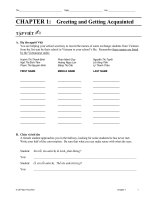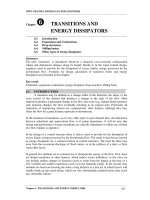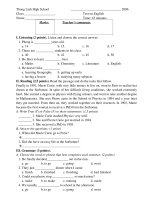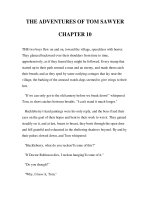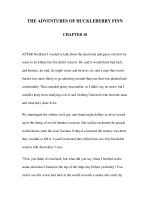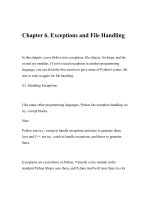Chapter 10: Criteria and Test Types doc
Bạn đang xem bản rút gọn của tài liệu. Xem và tải ngay bản đầy đủ của tài liệu tại đây (113.28 KB, 24 trang )
Chapter 10:
Criteria and Test Types
A. Criteria
1. Validity
2. Reliability
3. Discrimination
4. Administration
5. Test instructions to candidates
6. Backwash effects
1. Validity
Validity
the extent to which it
measures what it is supposed to
measure & nothing else (content)
Face validity
Content validity
Construct validity
Empirical validity
Face validity
If a test item looks right to other testers,
teachers, moderators & testees
described as
having face validity
In the past, regarded by test writers simply as a
public relations exercise
Now, designers of communicative tests: face
validity- the most important of all types of validity
Content validity
Depending on a careful analysis of the
language being tested & of the
particular course objective
When constructing tests, writers should
first draw up a table of test
specifications (language skills, areas
included…)
Construct validity
A test having construct validity is capable
of measuring specific characteristics in
accordance with a theory of language
behavior and learning
For example, a test consisting of multiple
choice items will lack construct validity if
the communicative approach is adopted
during the language course
Empirical /statistical validity
This kind of validity obtained as a result of comparing the
results of the test with the results of some criterion
measure such as:
An existing test, known to be valid and given at the same
time
The teacher’s ratings or any other such form of
independent assessment given at the same time
Empirical /statistical validity
The subsequent (later) performance of
the testees on a certain task measured
by some valid test
The teacher’s ratings or any other such
form of independent assessment given
later
Summary (Validity)
The test situation
The technique used
important factor in determining
the overall validity of any test
2. Reliability (definitions)
A test administrated to the same candidates
on different occasions produces the same
results
reliable
Reliability denotes the extent to which the
same marks /grades awarded if the same
test papers marked by
(i) 2 or more ≠ examiners
(ii) the same examiner on ≠ occasions
2. Reliability (affecting factors)
Reliability affected by the size of the sample
& the administration of the test
Other factors:
(1) test instructions (rubrics)
(2) personal factors like motivation & illness
(3) scoring of the test (the most important factor-
objective tests overcome this problem of
marker reliability)
2. Reliability (measuring methods)
(1) Re-administering the same test (the
same group of candidates) after a lapse
time
(2) Administering parallel forms of the test
to the same group (tests must be identical
in the nature of sampling, difficulty, length
& rubrics). If the correlation between 2
tests is high, the test can be termed
reliable.
3. Reliability versus Validity
2 chief criteria for evaluating any test
( an ideal test should be valid &
reliable)
The greater the reliability of a test, the
less validity it usually has.
4. Discrimination
An important feature of a test is its capacity:
(1) To discriminate among ≠ candidates
(2) To reflect the differences in the
performances of individuals in a group
The extent of the need to discriminate will
vary depending on the purpose of the test
5. Administration/Practicality
A test must be practicable, i.e. fairly straight
forward to administrate or able to
administrate (the length of time for
administrating, collecting answer sheets,
reading instructions).
Another practical consideration concerns
the answer sheets and the stationery used.
6. Test instructions to the candidates
All instructions are clearly written.
Samples are given.
Grammatical terminology should be
avoided.
7. Backwash effects
Def.: the influences of testing on teaching & learning
Positive backwash effect (reading tests
development of reading skills)
Negative backwash effect (objective tests
reducing
learners’ motivation
Implications: influences of tests on the compilation of
syllabus & language teaching programmes
B. Types of tests
1. Achievement /attainment tests
2. Proficiency tests
3. Aptitude tests
4. Diagnostic tests
1. Achievement /attainment tests
Class progress tests, the most widely
used types of tests
Achievement tests, formal tests
Class progress tests
Designed to measure the extent to which Ss
have mastered the material taught in the
classroom, allowing Ss to show what they
have mastered
Used as a teaching device: backwash effects
on teaching & motivation
Good tests
encouraging Ss to perform well
& gain confidence
Achievement tests
Intended to measure achievement on a large
scale, to show mastery of a particular syllabus
Standardized tests: pre-tested, items are
analysed & revised where necessary
A good achievement test should reflect the
particular approach to learning & teaching
adopted
2. Proficiency tests
Defining a student’s language
proficiency with reference to a
particular task which he/she will be
required to perform (TOEFL, TOEIC)
In no way related to any syllabus or
teaching programme
3. Aptitude tests
Designed to measure the Ss’ probable
performance in a foreign language which
he/she has not started to learn
Generally, seeking to predict Ss’ probable
strengths & weaknesses in learning a
foreign language by measuring
performance in an artificial language
4. Diagnostic tests
Achievement & proficiency tests:
frequently used for diagnostic purposes
such as diagnosing areas of difficulty Ss
may have so that appropriate remedial
action can be taken later.
Diagnostic testing: frequently carried out
for groups of Ss rather than for individuals
